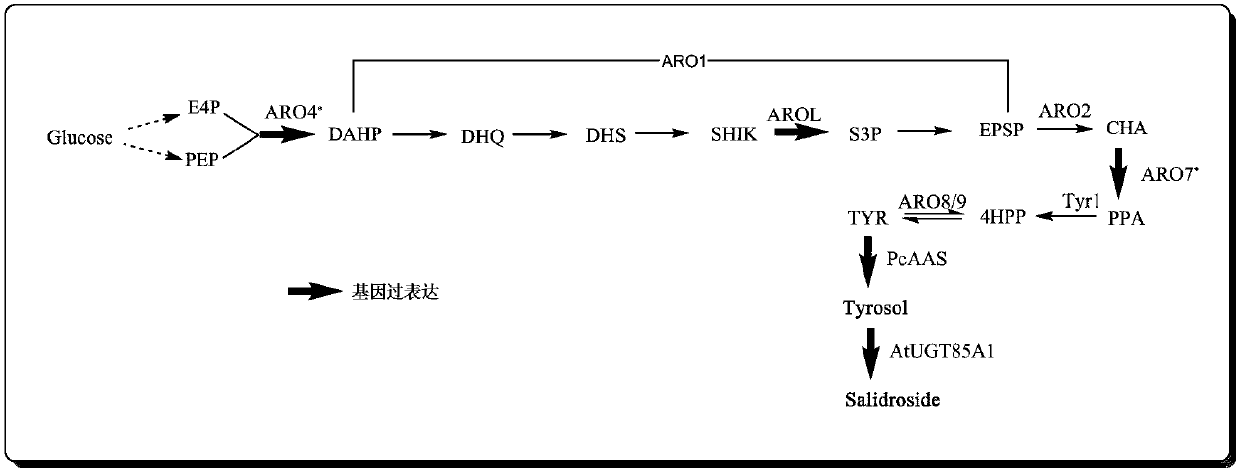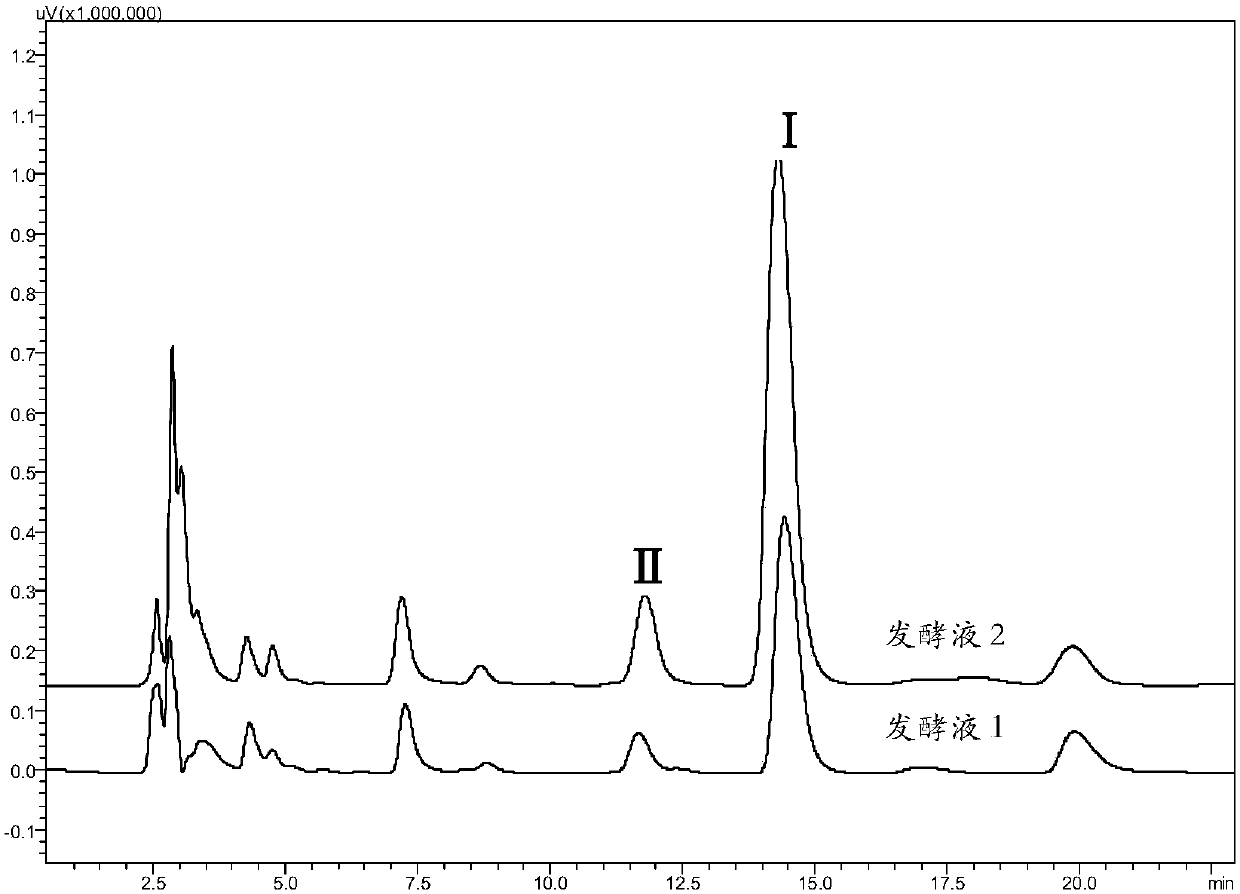Recombinant saccharomyces cerevisiae strain and application thereof to producing tyrosol and/or salidroside
A technology of Saccharomyces cerevisiae strain and salidroside, applied in the field of genetic engineering, can solve the problems of low yield and the like, and achieve the effects of fast reproduction, easy cultivation and convenient genetic manipulation
- Summary
- Abstract
- Description
- Claims
- Application Information
AI Technical Summary
Problems solved by technology
Method used
Image
Examples
preparation example Construction
[0042] In the present invention, the preparation method of the Saccharomyces cerevisiae strain M5 preferably includes: the construction method of the recombinant plasmid pESC-URA3-TEF1-AROL-TDH3-ARO7*-PGK1-ARO4* and the recombinant plasmid pESC-LEU2-TEF1-TDH3- The construction method of PcAAS-PGK1-AtUGT85A1;
[0043] The prepared recombinant plasmid pESC-URA3-TEF1-AROL-TDH3-ARO7*-PGK1-ARO4* and recombinant plasmid pESC-LEU2-TEF1-TDH3-PcAAS-PGK1-AtUGT85A1 were transformed into Saccharomyces cerevisiae according to conventional methods to form Saccharomyces cerevisiae strains -M5.
[0044] In the present invention, the construction method of the recombinant plasmid pESC-URA3-TEF1-AROL-TDH3-ARO7*-PGK1-ARO4* comprises the following steps:
[0045] I. Using yeast genomic DNA as a template, using primers ScTEF1-AvrII and ScTEF1-AtaII, PCR amplified TEF1 promoter, obtained TEF1 promoter PCR product and pESC-URA3 digested with AvrII and AtaII, connected to obtain pESC-URA3 -TEF1;
...
Embodiment 1
[0074] Construction of expression strain BY4742-M5 of Saccharomyces cerevisiae
[0075] The plasmids pESC-URA3-TEF1-AROL-TDH3-ARO7*-PGK1-ARO4*, pESC-LEU2-TEF1-TDH3-PcAAS-PGK1-AtUGT85A1 were transformed into Saccharomyces cerevisiae BY4742 strain by chemical transformation.
[0076] The transformation method is as follows: take 100 μl of competent Saccharomyces cerevisiae, centrifuge to remove the supernatant, add 240 μl of 50% PEG3350, 36 μl of 1M LiAc, 100 μg of salmon essence, pESC-URA3-TEF1-AROL-TDH3-ARO7*-PGK1 -ARO4*, pESC-LEU2-TEF1-TDH3-PcAAS-PGK1-AtUGT85A1 plasmids 10μl each, and finally make up to 360μl system with water, mix gently, incubate at 30°C for 30 minutes, then heat shock at 42°C for 40 minutes After taking it out, centrifuge to remove the supernatant, add water to mix and spread on the SC plate containing uracil and leucine auxotrophs. Uracil and leucine auxotrophs were used to screen the transformed strain carrying two expression vectors at the same time, n...
Embodiment 2
[0078] This example is used to illustrate the construction of Saccharomyces cerevisiae expression strain BY4742-IM5
[0079] (1) Use Chr-URA3-F, Chr-URA3-R, ARO4*-F, ARO4*-R, ARO7*-F, ARO7*-R, AROL-F, AROL-R as primers to amplify gene integration fragments URA3, TEF1-AROL-CYC1t, TDH3-ARO7*-TEF1tPGK1-ARO4*-ADH1t. PCR reaction system: 10 μl of 5×Q5 buffer, 5 μl of 2mM dNTP, 2.5 μl of 10 μM forward primer, 2.5 μl of 10 μM reverse primer, 1 μl of template, 0.5 μl of Q5 high-fidelity DNA polymerase, and 28.5 μl of water. The reaction program is: pre-denaturation at 98°C for 30 seconds; denaturation at 98°C for 10 seconds, annealing at 56°C for 30 seconds, extension at 72°C for 2 minutes, 30 cycles; extension at 72°C for 2 minutes to obtain the target DNA fragment.
[0080] (2) Transfer the PCR amplified bands into Saccharomyces cerevisiae BY4742 strain by chemical transformation, the transformation method is specifically: take 100 μl of competent Saccharomyces cerevisiae, centrifu...
PUM
 Login to View More
Login to View More Abstract
Description
Claims
Application Information
 Login to View More
Login to View More - R&D
- Intellectual Property
- Life Sciences
- Materials
- Tech Scout
- Unparalleled Data Quality
- Higher Quality Content
- 60% Fewer Hallucinations
Browse by: Latest US Patents, China's latest patents, Technical Efficacy Thesaurus, Application Domain, Technology Topic, Popular Technical Reports.
© 2025 PatSnap. All rights reserved.Legal|Privacy policy|Modern Slavery Act Transparency Statement|Sitemap|About US| Contact US: help@patsnap.com



